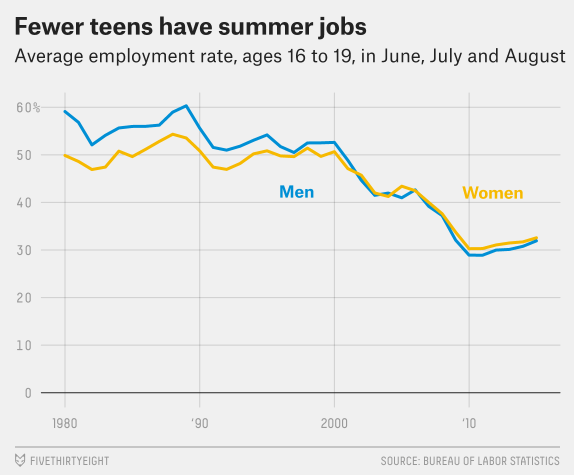Chart: What Percentage of Teens Have Summer Jobs?
Answer: About 30% of 16-19 year olds are working during the summer.
From Nate Silver’s blog 528:
Questions for your students:
- Do/did you have a summer job?
- How did you get the job? or Why didn’t you get a job?
- What did you learn from the experience?
- What tips would you give someone who didn’t get a job?
More from 529 about the how family income impacts the ability of young people to get jobs:
Young Americans from low-income families have been especially hard-hit by the decline in summer employment. According to data from the Current Population Survey, teenagers whose families make less than $20,000 per year are now less than half as likely to work as those from families who earn at least $100,000, and, unlike their wealthier peers, low-income teens have seen hardly any rebound in employment since the recession ended. (Black and Hispanic teens, too, have far lower employment rates than whites.)
Teens from less privileged backgrounds face numerous barriers to finding jobs. They are less likely to own a car (or have access to one), and often live in areas where jobs are scarce. Their parents are less likely to be able to help them get a foot in the door at a local business. They may attend schools that are, or are perceived as, inferior, making them less attractive to prospective employers. And they may face discrimination based on race, class or other factors. None of those barriers is new, of course, but they may have grown higher as the U.S. has become more unequal and more segregated by class.
Want this resource and questions in slide format to use in class? Click here!
_______
Be sure to check out our popular Career Activity: Create A Famous Person’s LinkedIn Profile
About the Author
Tim Ranzetta
Tim's saving habits started at seven when a neighbor with a broken hip gave him a dog walking job. Her recovery, which took almost a year, resulted in Tim getting to know the bank tellers quite well (and accumulating a savings account balance of over $300!). His recent entrepreneurial adventures have included driving a shredding truck, analyzing executive compensation packages for Fortune 500 companies and helping families make better college financing decisions. After volunteering in 2010 to create and teach a personal finance program at Eastside College Prep in East Palo Alto, Tim saw firsthand the impact of an engaging and activity-based curriculum, which inspired him to start a new non-profit, Next Gen Personal Finance.
SEARCH FOR CONTENT
Subscribe to the blog
Join the more than 11,000 teachers who get the NGPF daily blog delivered to their inbox:
MOST POPULAR POSTS











